10 After Care Tips for Optimal Post-Surgery Recovery

Overview
Achieving optimal post-surgery recovery necessitates a holistic approach that encompasses:
- Effective wound care
- Pain management
- A balanced diet
- Hydration
- Rest
- Gentle physical activity
- Mental well-being support
- Community engagement
Each of these strategies is interconnected, highlighting the importance of addressing both physical and emotional health. This comprehensive focus significantly enhances healing outcomes, underscoring the necessity of a multifaceted recovery plan. By embracing these principles, individuals can foster a more effective healing process, ultimately leading to improved recovery experiences.
Introduction
The journey to recovery after surgery often presents significant challenges, yet it also offers a unique opportunity for individuals to reclaim their health and well-being. By implementing the right aftercare strategies, patients can enhance their healing process and facilitate a smoother transition back to daily life. What essential practices can support physical recovery while nurturing emotional resilience during this critical period? This article explores ten vital aftercare tips designed to optimize post-surgery recovery, providing insights into holistic approaches that address both body and mind.
Tsavo Wellness: Holistic Recovery Solutions for Post-Surgery Care
Tsavo Wellness, located in Mosman, Sydney, is dedicated to delivering advanced therapies that ensure optimal healing and after care post-surgery. With a focus on a holistic approach, the center provides a diverse range of services, including:
- Infrared Saunas
- Hyperbaric Oxygen Therapy (HBOT)
- Lymphatic Massage
Each service is meticulously designed to enhance healing and overall vitality.
Infrared saunas play a crucial role in promoting detoxification and improving circulation, both vital for effective healing. By employing infrared light that penetrates the skin, these saunas alleviate muscle tension and enhance skin health, establishing themselves as an indispensable part of post-operative care.
Hyperbaric Oxygen Therapy at Tsavo Wellness administers pure oxygen in a pressurized environment, significantly accelerating the healing process. This innovative therapy can increase the vital oxygen supply to cells and tissues by up to 50%, fostering healing at the cellular level while reducing inflammation. Regular sessions can lead to heightened energy levels, improved mental clarity, and strengthened immune support, all essential components for a successful recovery.
Lymphatic Massage complements these therapies by stimulating the lymphatic system, enhancing circulation, and promoting detoxification. This treatment not only aids in physical recovery but also bolsters emotional well-being, allowing clients to feel rejuvenated and balanced.
The integration of these advanced therapies positions Tsavo Wellness as a premier destination for comprehensive after care, effectively addressing both physical and mental health needs. As wellness specialists emphasize, a tranquil mind and a nurturing atmosphere are vital for efficient restoration, making Tsavo Wellness a sanctuary for those on their journey to wellness.

Prioritize Wound Care: Essential Practices for Healing
Effective wound care is crucial for ensuring a smooth healing process. Following the surgeon's instructions on cleaning, dressing changes, and monitoring for signs of infection is paramount. By maintaining cleanliness and dryness of the wound, avoiding snug garments in the area, and applying recommended ointments, recovery can be significantly enhanced. Notably, statistics reveal that proper wound care can reduce infection rates by up to 50%, highlighting its critical importance.
Regular checks for unusual redness, swelling, or discharge are vital for the early detection of potential complications. Real-life examples demonstrate that individuals who consistently follow wound care protocols experience quicker healing times and improved outcomes. Engaging with healthcare professionals for advice on current best practices ensures that individuals remain well-informed and prepared for optimal healing.
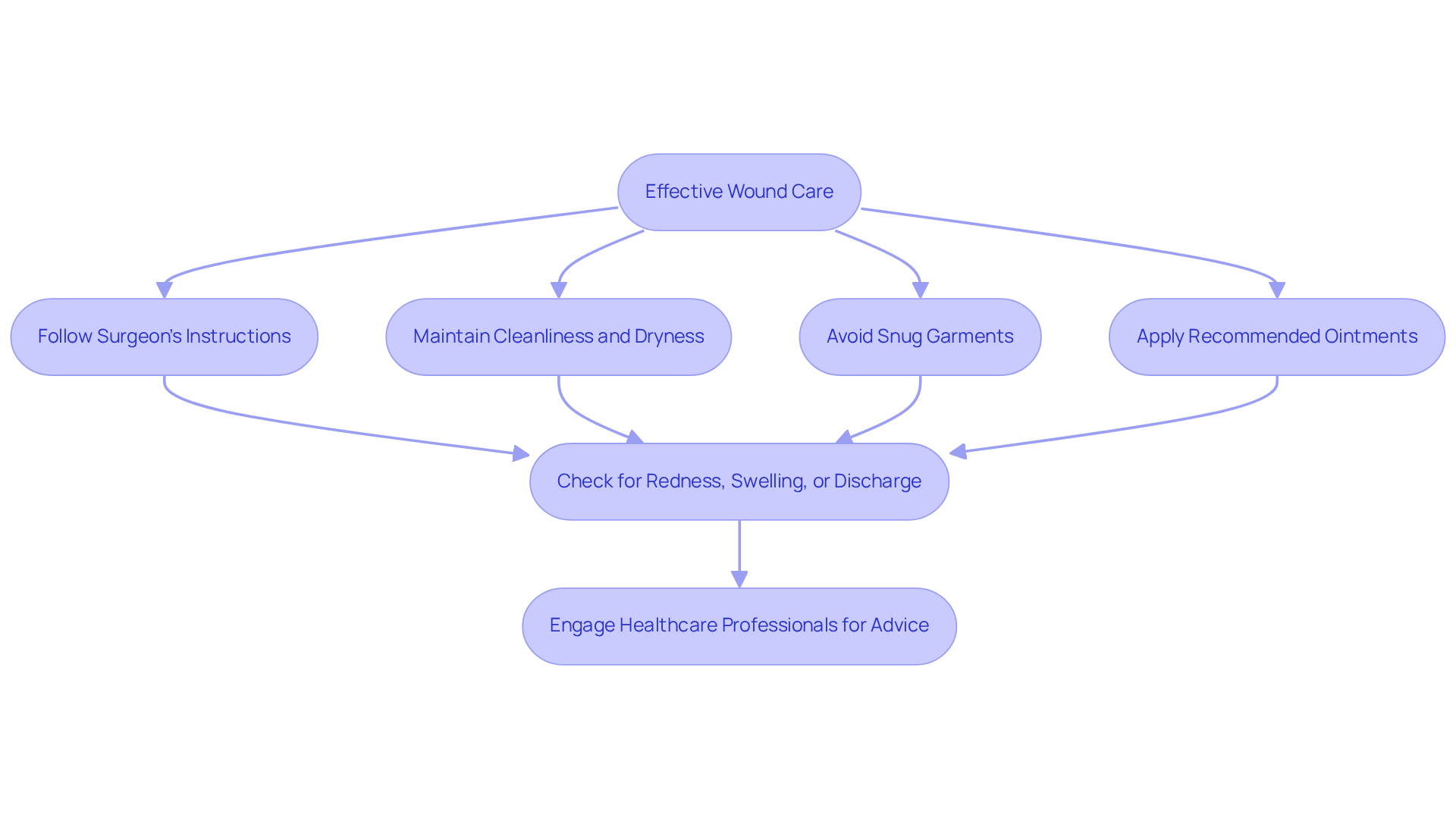
Implement Effective Pain Management Techniques
Post-surgery pain management demands a comprehensive approach that integrates medications, physical therapy, and alternative therapies. Engaging in discussions with healthcare providers about pain relief options is crucial for patients. These options may encompass:
- Over-the-counter pain relievers such as paracetamol and ibuprofen
- Prescribed medications
- Non-pharmacological methods like acupuncture and relaxation techniques
Notably, research reveals that a systematic review identified massage therapy as effective in controlling postoperative pain, demonstrating a significant reduction in pain levels compared to standard care.
Keeping a pain diary is instrumental in tracking pain intensity and evaluating the effectiveness of various management strategies. This practice allows for timely adjustments to the pain management plan, ensuring it meets individual needs. A tailored pain management strategy, designed around personal requirements and medical history, can significantly enhance healing outcomes. Furthermore, integrating alternative therapies can complement traditional pain relief methods, potentially reducing reliance on opioids and boosting overall patient satisfaction.
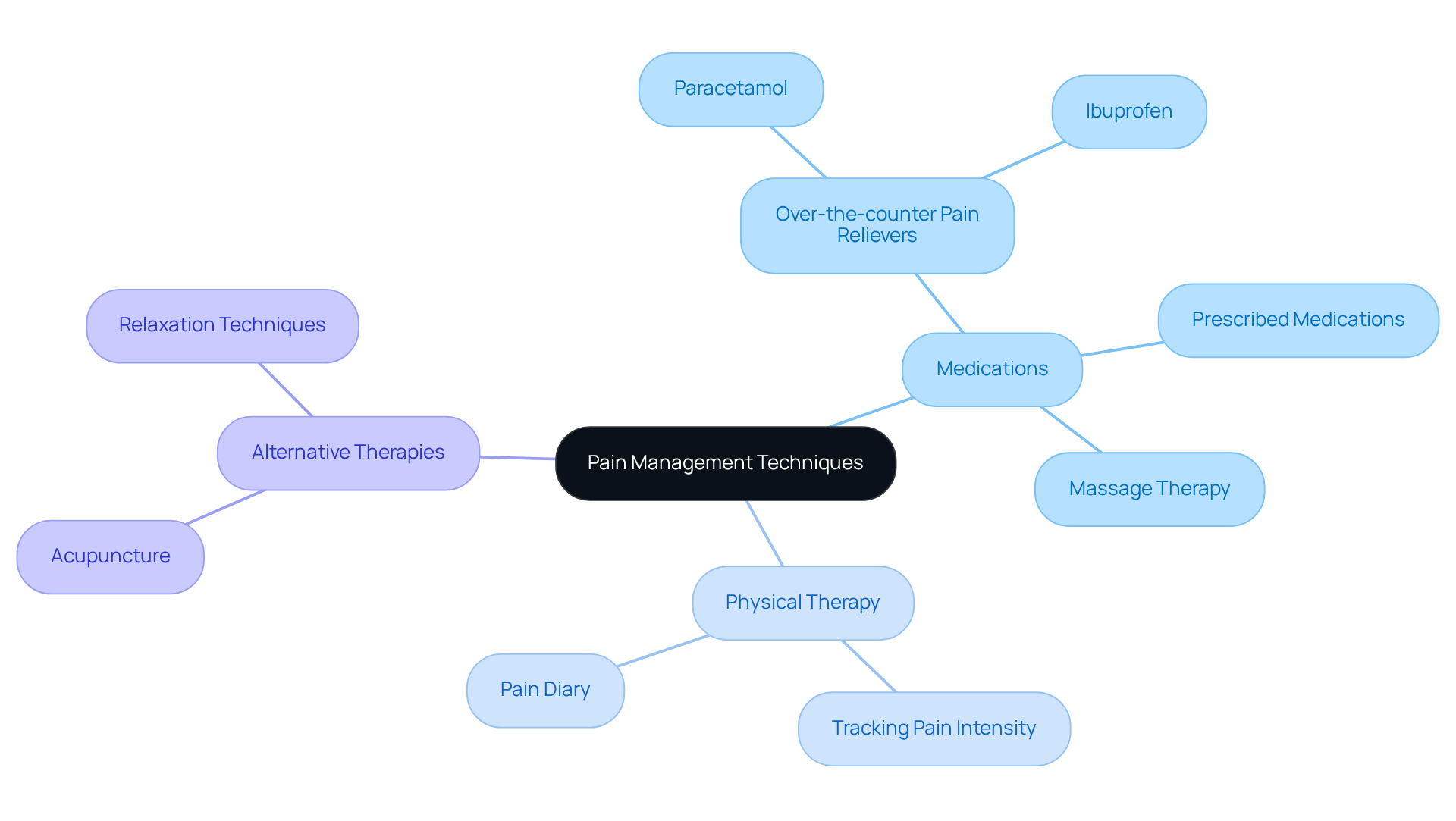
Maintain a Balanced Diet: Fuel Your Recovery
A balanced diet abundant in vitamins, minerals, and protein is crucial for effective recovery after surgery. Foods rich in protein—such as lean meats, fish, eggs, and legumes—are vital for tissue repair and muscle maintenance. Moreover, incorporating a variety of colorful fruits and vegetables not only provides essential antioxidants that help reduce inflammation but also supports overall health. For instance, foods high in vitamin C, like strawberries and bell peppers, are especially beneficial for repairing wounds. Additionally, magnesium, found in foods such as avocados and leafy greens, aids in healing broken tissue and reducing swelling. HMB (beta-hydroxy-beta-methylbutyrate) is also essential for promoting muscle health during the healing process.
Furthermore, being mindful of portion sizes and having regular, smaller meals can sustain energy levels and enhance nutrient absorption during recovery. Hydration is equally important; water facilitates nutrient transport and overall bodily functions. This comprehensive approach not only aids in physical recuperation but also enhances mental well-being, making it an integral part of after care following surgery.

Stay Hydrated: The Key to Optimal Recovery
Hydration is crucial for optimal recovery after care post-surgery. Water plays a vital role in transporting nutrients, assisting digestion, and removing waste—processes that are essential during recovery. Patients must prioritize fluid intake, particularly water, and consider electrolyte-rich beverages if they experience significant fluid loss. Monitoring urine color serves as an effective gauge of hydration levels; a clear or light yellow hue indicates adequate hydration.
Real-world examples underscore the importance of hydration in healing:
- A study demonstrated that sufficient fluid consumption significantly enhances collagen production, leading to tougher and more flexible scars, which is an essential factor in after care during post-surgery recovery.
- Additionally, hydration aids in the elimination of toxins such as lactic acid, further promoting recuperation and overall health.
- Health experts emphasize that proper after care for dehydration can prevent complications, as it impedes recovery and increases the risk of issues like blood clots and delayed wound healing.
Dr. Kevin Ho, a specialist plastic surgeon, asserts, "Staying hydrated is about keeping your body’s fluid levels balanced so it can function properly."
Integrating these hydration strategies not only supports restoration but also enhances overall well-being during after care, ensuring a smoother recuperation process.

Schedule Follow-Up Appointments: Ensure Continuous Care
Scheduling follow-up appointments with healthcare providers is vital for a successful healing process. These visits not only assess recovery progress but also facilitate the management of complications and necessary adjustments to care plans. Research indicates that individuals who engage in routine follow-up visits experience significantly improved healing outcomes, including reduced complication rates and expedited healing times.
During these appointments, individuals should come prepared with a list of questions or concerns to address, such as:
- Changes in symptoms
- Strategies for pain management
- Any new health issues that may have emerged
Open dialogue with healthcare providers cultivates trust and enhances the overall care experience. For instance, individuals who actively participate in their follow-up care often report feeling more empowered and informed about their healing journey. As one healthcare provider noted, 'Effective after care is a collaborative effort where insights from individuals receiving after care are invaluable.'
By prioritizing these follow-up visits, patients can ensure they receive the comprehensive care essential for optimal healing.

Prioritize Rest and Sleep: Essential for Healing
Rest and quality sleep are paramount for effective healing after surgery. During sleep, the body engages in vital repair processes, including muscle restoration and enhancement of immune function, both critical for recuperation. Research indicates that adequate sleep significantly influences surgical healing outcomes; improved sleep quality correlates with faster recovery and reduced complications.
To cultivate a restful environment, patients should:
- Minimize noise and light
- Invest in comfortable bedding
- Adhere to a consistent sleep schedule
Strategies such as:
- Employing blackout curtains
- Utilizing white noise machines
- Maintaining a cool room temperature
can further optimize sleep quality. Should sleep disturbances arise, consulting with a healthcare provider is essential to identify potential solutions, ensuring a smoother healing process.
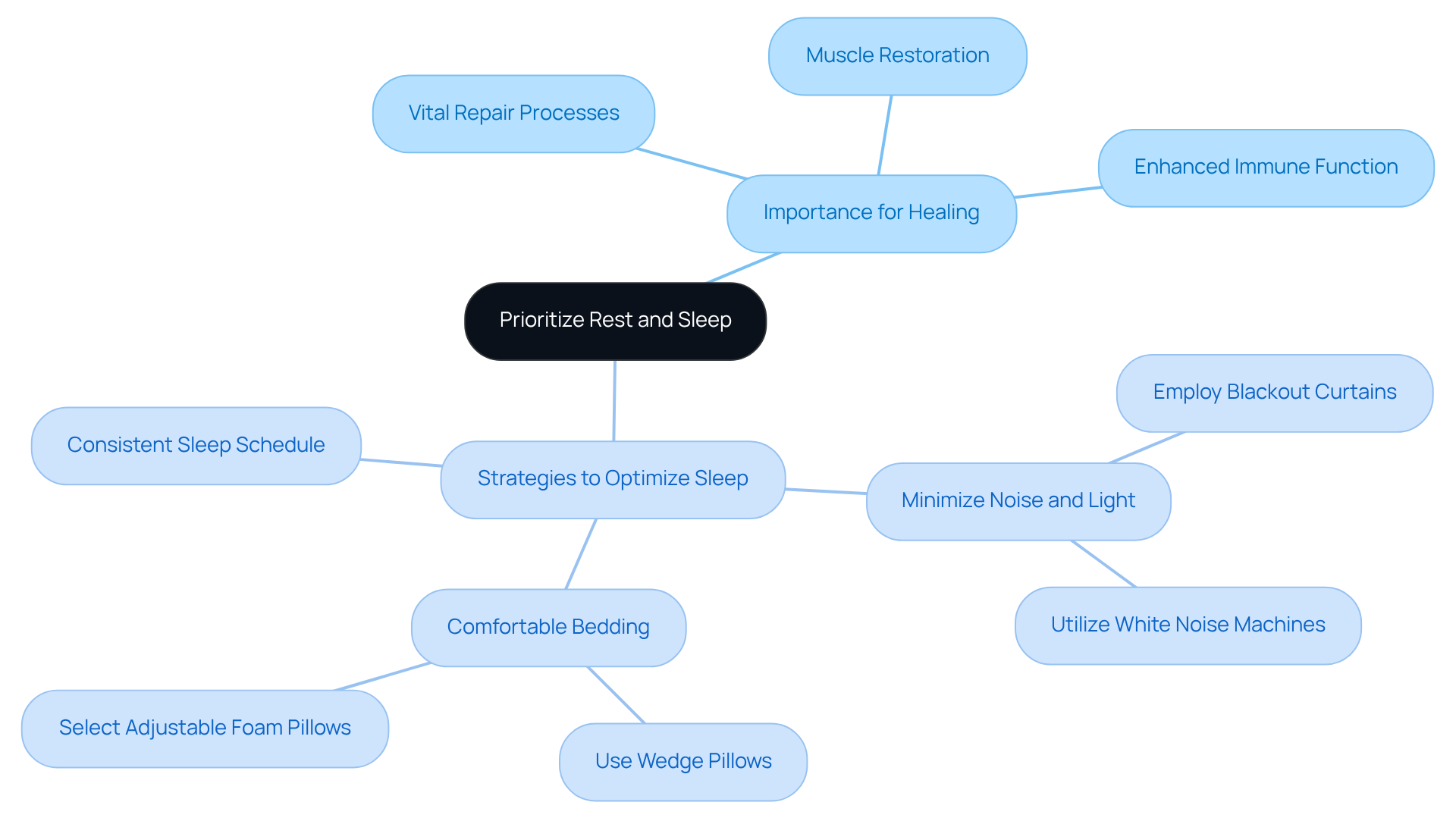
Incorporate Gentle Physical Activity: Promote Healing
Incorporating gentle physical activity, such as walking or stretching, is essential for promoting recovery and preventing complications, including blood clots. Patients should consult their healthcare provider to determine the appropriate timing and types of activities to initiate. Generally, most individuals can resume light activities within three to four days post-surgery, with a gradual increase in intensity recommended to effectively restore strength and mobility.
For example, starting with short walks can significantly enhance circulation and support digestive health, alleviating issues like constipation caused by anesthesia. Dr. Bajaj emphasizes that walking reduces the risk of deep venous thrombosis (DVT) and stimulates bowel movement. Physical therapists stress the importance of listening to one's body; any activity that causes extreme discomfort should be discontinued.
As rehabilitation progresses, low-impact exercises such as gentle Pilates or stationary cycling can be introduced, ensuring a safe return to normal activity while respecting the body's healing process. Furthermore, individuals should avoid pools, hot tubs, and natural water sources until all incisions are fully healed, typically at least three to four weeks following the procedure.
This approach not only promotes physical healing but also enhances emotional wellness, as engaging in movement can trigger the release of endorphins, improving overall mood throughout the healing journey. Remember, your body hears everything your mind says; maintain a positive mindset.
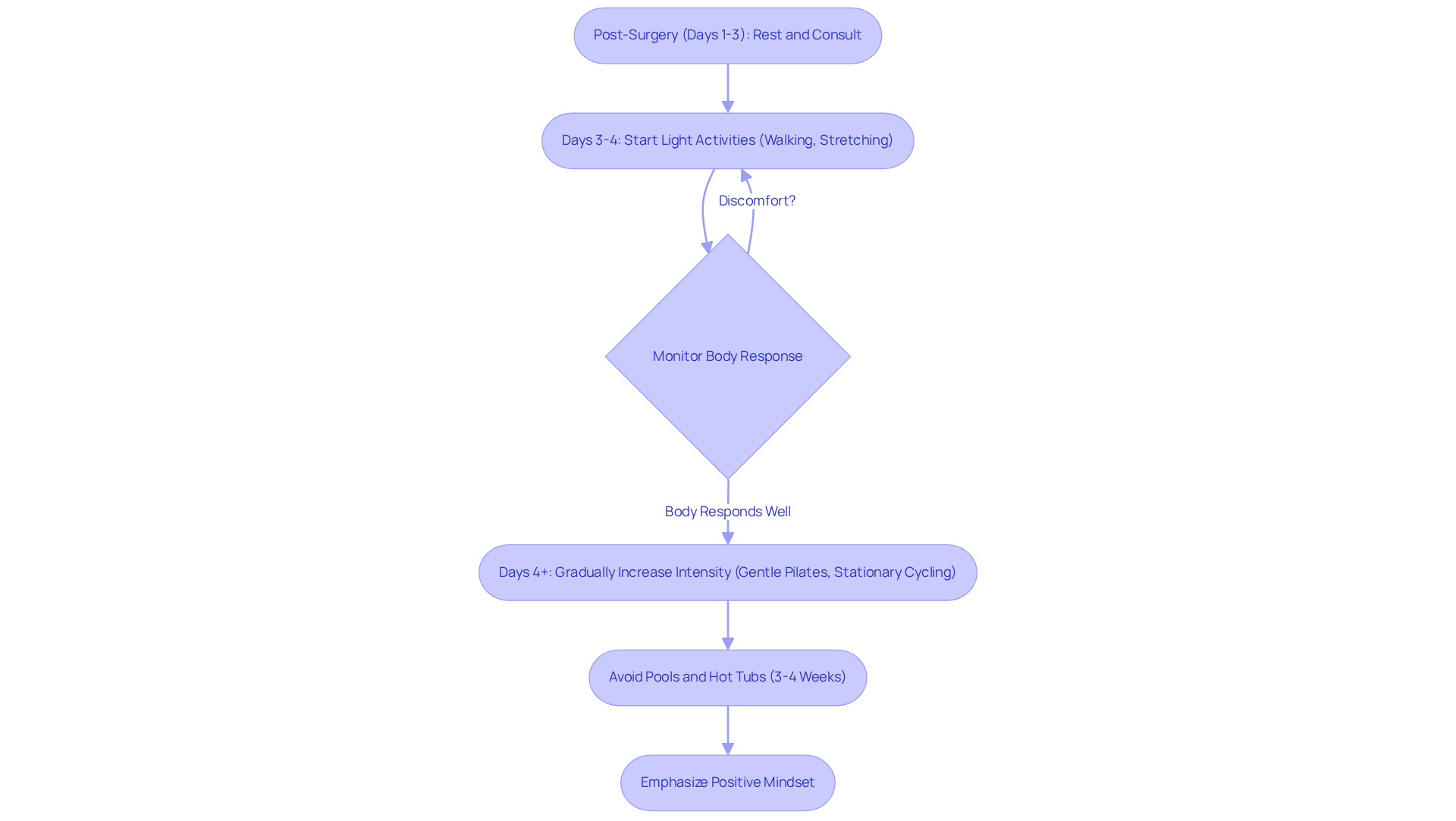
Support Mental Well-Being: Address Emotional Health Post-Surgery
Post-surgery healing presents significant emotional challenges, as patients frequently encounter anxiety, depression, or mood swings. The World Health Organization underscores that mental health is integral to overall health, emphasizing the need for emotional well-being strategies during rehabilitation. Engaging in activities that foster mental well-being—such as mindfulness, meditation, or therapy—proves beneficial. As Oprah Winfrey aptly stated, "Turn your wounds into wisdom," illustrating the transformative potential of confronting emotional hurdles.
Moreover, connecting with friends and family can alleviate feelings of isolation and foster a positive outlook during the healing journey. Research indicates that social support is vital for enhancing recovery outcomes, as emotional connections provide comfort and motivation. Individuals who actively seek emotional support often report improved mental health and a more optimistic perspective throughout their healing process.
Recent studies further highlight the critical role of emotional well-being post-surgery, revealing that individuals with strong emotional networks experience fewer complications and faster recovery times. A case study featuring Michelle Obama reinforces the necessity of prioritizing mental health with the same seriousness as physical health, advocating for open dialogues and acceptance. This reinforces the imperative of integrating emotional well-being strategies into after care plans, ensuring that individuals not only achieve physical healing but also maintain their mental health during their recovery.
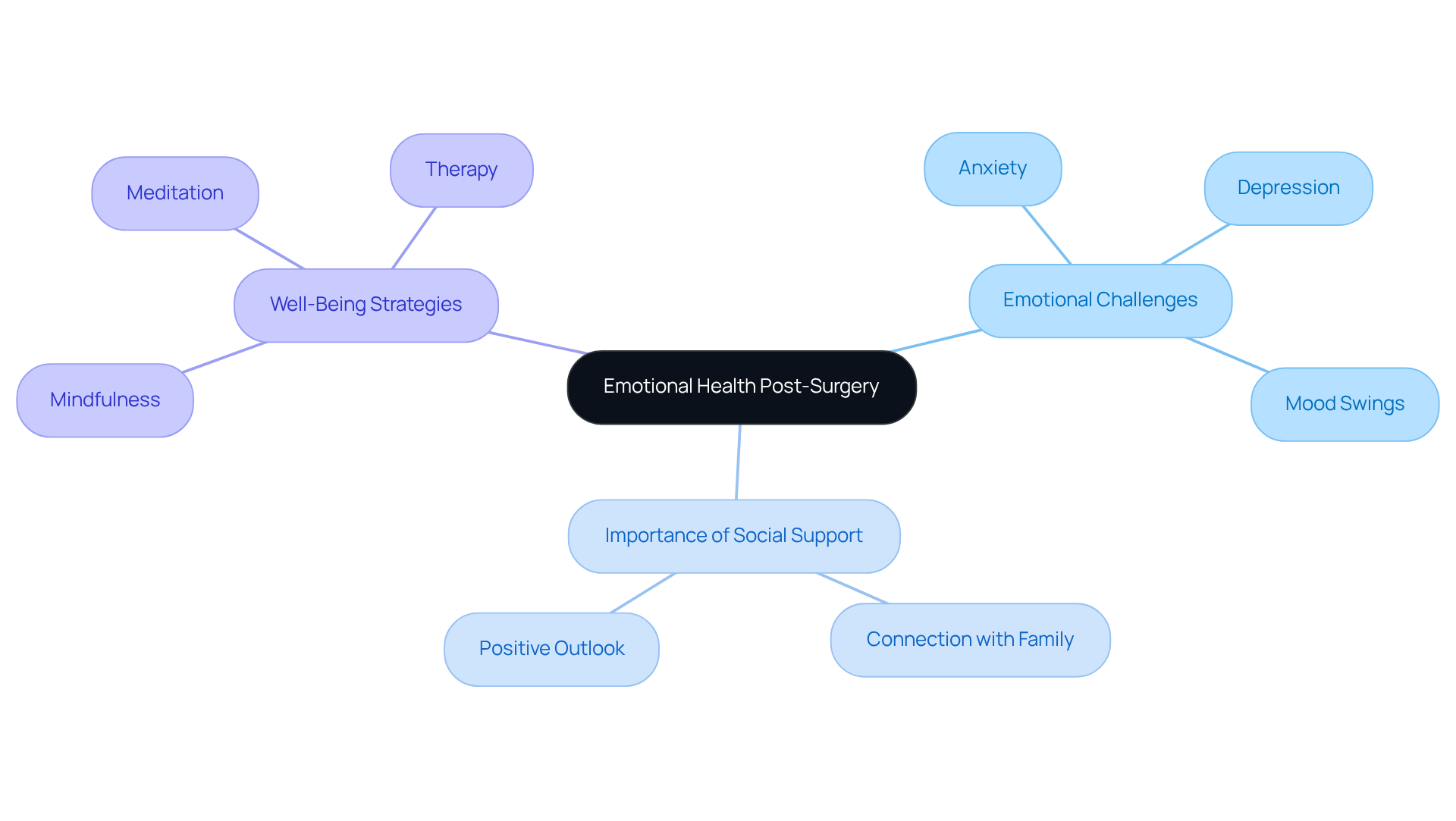
Engage with Community Support: Enhance Your Recovery Journey
Participating in community assistance—whether through assistance groups, online discussions, or local wellness initiatives—can significantly enhance the healing process for post-surgery patients. By sharing experiences with others who have undergone similar procedures, individuals foster a sense of connection that provides valuable insights and encouragement. Assistance groups create a safe environment for discussing challenges and triumphs, which can be incredibly empowering.
Moreover, community resources offer practical support, such as meal delivery services or transportation, alleviating stress during recovery. Research indicates that patients engaged in assistance groups exhibit improved coping abilities and a heightened sense of responsibility—both vital for maintaining a positive healing trajectory. Studies reveal that individuals with robust social connections tend to remain in treatment longer and achieve better healing outcomes.
Wellness coaches emphasize the importance of these connections, asserting that "assistance groups provide not only emotional encouragement but also practical guidance that can lead to meaningful impacts on healing results." Lauren Carey, a registered dietitian, notes that "participation in group meetings may assist individuals in revitalizing their dedication to maintaining a healthy lifestyle and reconnecting with their bariatric team." Numerous surgical patients have demonstrated that consistent participation in group meetings increases motivation and enhances their understanding of the healing journey. Ultimately, leveraging community support can lead to a more holistic and effective recovery experience.
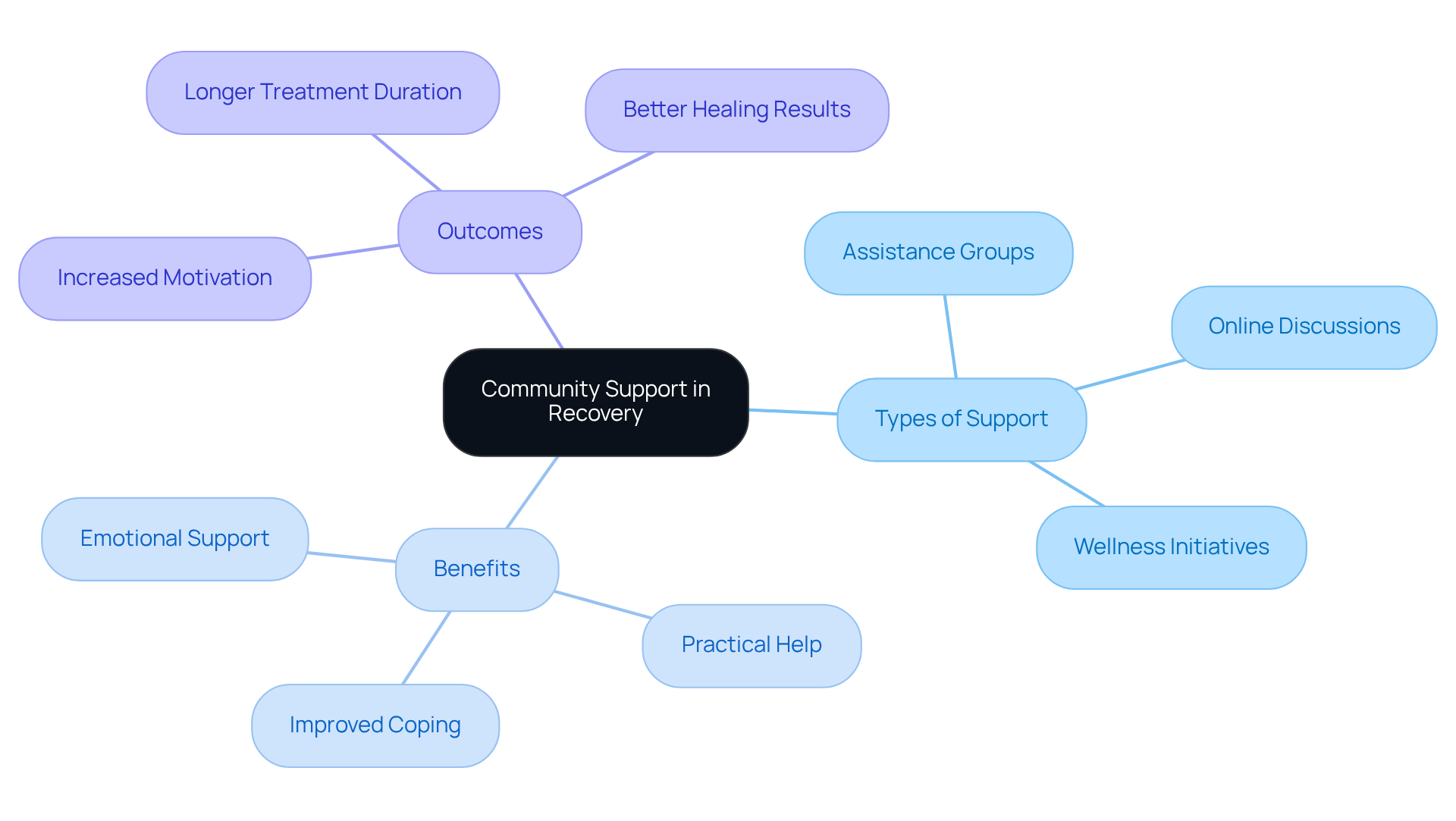
Conclusion
Optimal post-surgery recovery is predicated on a multifaceted approach that prioritizes both physical and emotional well-being. By incorporating:
- Advanced therapies
- Effective wound care
- Pain management
- Balanced nutrition
- Hydration
- Follow-up appointments
- Rest
- Gentle activity
- Mental health support
- Community engagement
individuals can significantly enhance their healing journey. Each of these elements plays a vital role in ensuring a smoother recovery process, empowering patients to regain their strength and vitality.
Key insights from the article underscore the importance of holistic care. Therapies such as hyperbaric oxygen and lymphatic massage not only facilitate physical recovery but also bolster emotional health. Furthermore, maintaining a balanced diet rich in essential nutrients and ensuring adequate hydration are critical for optimal healing. Regular follow-ups with healthcare providers are essential to promptly address any complications, while prioritizing rest and gentle physical activity fosters both physical and mental rejuvenation.
Ultimately, embracing a comprehensive recovery strategy that includes community support and emotional well-being can transform the post-surgery experience. Engaging with others who share similar journeys provides encouragement and valuable insights, reinforcing the notion that healing is a collaborative effort. By adopting these best practices, individuals can navigate their recovery with confidence, paving the way for a healthier and more fulfilling life post-surgery.
Frequently Asked Questions
What services does Tsavo Wellness provide for post-surgery care?
Tsavo Wellness offers a range of advanced therapies for post-surgery care, including Infrared Saunas, Hyperbaric Oxygen Therapy (HBOT), and Lymphatic Massage.
How do Infrared Saunas aid in post-operative recovery?
Infrared Saunas promote detoxification and improve circulation, which are vital for healing. They alleviate muscle tension and enhance skin health, making them an essential part of post-operative care.
What is Hyperbaric Oxygen Therapy and its benefits?
Hyperbaric Oxygen Therapy administers pure oxygen in a pressurized environment, accelerating the healing process by increasing oxygen supply to cells and tissues. Benefits include reduced inflammation, heightened energy levels, improved mental clarity, and strengthened immune support.
How does Lymphatic Massage contribute to recovery?
Lymphatic Massage stimulates the lymphatic system, enhances circulation, and promotes detoxification, aiding physical recovery and bolstering emotional well-being.
Why is effective wound care important after surgery?
Effective wound care is crucial for a smooth healing process, as it can reduce infection rates by up to 50%. Following surgeon's instructions on cleaning, dressing changes, and monitoring for infection signs is essential.
What are some key practices for effective wound care?
Key practices include maintaining cleanliness and dryness of the wound, avoiding snug garments in the area, applying recommended ointments, and regularly checking for unusual redness, swelling, or discharge.
What approaches are recommended for post-surgery pain management?
A comprehensive approach to pain management includes medications, physical therapy, and alternative therapies. Options may include over-the-counter pain relievers, prescribed medications, acupuncture, and relaxation techniques.
How can keeping a pain diary assist in pain management?
Keeping a pain diary helps track pain intensity and evaluate the effectiveness of various management strategies, allowing for timely adjustments to the pain management plan to meet individual needs.
What role do alternative therapies play in pain management?
Integrating alternative therapies can complement traditional pain relief methods, potentially reducing reliance on opioids and improving overall patient satisfaction.


